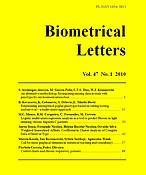
Biometrical Letters vol. 47(1), 2010, pp. 33-44


|
LOGISTIC MULTIVARIATE REGRESSION ANALYSIS AS A TOOL TO PREDICT FIBROSIS IN LIGHT-DRINKING CHRONIC HEPATITIS C PATIENTS
M.C. Manso1, R.M. Cerqueira2, C. Fernandes2, M. Correia2 1University Fernando Pessoa, Faculty of Health Sciences, Rua Carlos da Maia, 296 4200-150 Porto, Portugal / REQUIMTE-UP, e-mail: cmanso@ufp.edu.pt 2Gastroenterology Department, Sáo Sebastiáo Hospital, Rua Dr. Cândido de Pinho, 4520-211 Santa Maria da Feira, Portugal |

Complications of the chronic hepatitis C virus (HCV) include the development of fibrosis, which depends on host and viral characteristics. In most studies moderate and heavy alcohol intake is a risk factor for hepatic fibrosis. However, there is a lack of data on the effects of light alcohol intake on HCV disease progression.
In this work the independent effect of significant variables (p < 0.05) on fibrosis was assessed using backward stepwise binary logistic multivariate regression analysis (0.05 for factor inclusion and 0.2 for exclusion). Data were collected in a retrospective cross-sectional study of 99 untreated HCV patients (79.4% male, age (mean ± SD) 35.2 ± 10.3 years) with liver biopsy who drank up to 30 g alcohol daily (8.3 ± 10.7 g). The prevalence of fibrosis (METAVIR >= 2) in this group was 40.4% (95% CI: 30.7% - 50.1%). Age, elevated GPT ( >= 2 x upper normal limit), steatosis ( >= 5%) and viral load ( >= 800,000 UI/mL) remained in the model. The area under the curve (AUC) derived from this model was 0.776 (95%CI: 0.685 - 0.868) for fibrosis in light-drinking chronic hepatitis C patients. The sensitivity and specificity for predicting severe hepatic fibrosis were 0.64 and 0.77 respectively.
In this work the independent effect of significant variables (p < 0.05) on fibrosis was assessed using backward stepwise binary logistic multivariate regression analysis (0.05 for factor inclusion and 0.2 for exclusion). Data were collected in a retrospective cross-sectional study of 99 untreated HCV patients (79.4% male, age (mean ± SD) 35.2 ± 10.3 years) with liver biopsy who drank up to 30 g alcohol daily (8.3 ± 10.7 g). The prevalence of fibrosis (METAVIR >= 2) in this group was 40.4% (95% CI: 30.7% - 50.1%). Age, elevated GPT ( >= 2 x upper normal limit), steatosis ( >= 5%) and viral load ( >= 800,000 UI/mL) remained in the model. The area under the curve (AUC) derived from this model was 0.776 (95%CI: 0.685 - 0.868) for fibrosis in light-drinking chronic hepatitis C patients. The sensitivity and specificity for predicting severe hepatic fibrosis were 0.64 and 0.77 respectively.

logistic model, multivariate analysis, backward stepwise method, fibrosis, chronic hepatitis C
